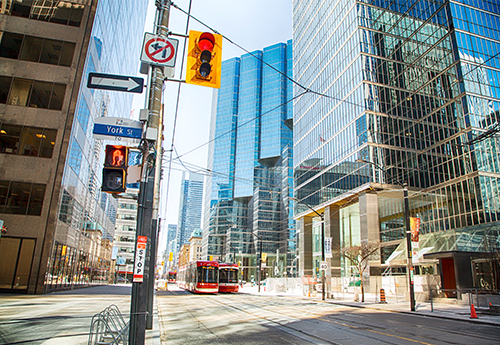Searching for value in today’s property markets

Unprecedented levels of fiscal stimulus combined with low interest rates conspired to create fully priced developed markets across the spectrum of asset classes by the end of 2020. Real estate was not exempt from these trends, quite the contrary. Due to traditional leverage levels being generally higher than other asset classes, real estate returns overall have benefited disproportionately. Not just for single family homes but also for apartments. Well-leased commercial properties of all kinds continue to perform well, while Investor appetites vary widely between property types and locations. This article is designed to shed light on the winning and lagging strategies and recommend: With an unprecedented amount of money chasing deals, where can investors look for best value?
Overall, trading volumes decreased for commercial property during 2020 by 30-50% as restrictions on travel, eviction and foreclosures and general opacity of the medium-term impact of the pandemic on the property sector were impediments to normal capital flows. In general, larger markets - the traditional recipients of international capital flows - have been the slowest to recover. In the early stages of lockdowns, conditional appraisals were common, with those restrictions lifting first on industrial and residential product, then grocery anchored strip shopping centers, where transaction evidence first materialized. Hotels, offices and enclosed retail on the other hand, continue to see significant bid/ask gaps as the long-term impacts of work from home, sharply rising e-commerce rates and new models of working look increasingly persistent. Many businesses that adopted a “wait and see” attitude during the pandemic, have begun to make decisions by Q3, 2021, even in those locations where heavy reliance on public transit has delayed workers returning to pre-pandemic patterns. As a result, transaction volumes have largely returned to pre-pandemic levels (other than for office leasing, which continues to lag).
The public markets provide some of the clearest evidence of the pricing trends, with year to date through September 30 returns for the Canadian REIT index up 24.2% versus the TSX at 17.0%. Industrial and residential REITs are strongly outperforming other sectors, for example Summit Industrial REIT is up 56% year to date as compared to bellwether Allied office REIT up only 8% year to date. At the ground level, the industrial and residential rental markets are posting some of the strongest rental growth seen in many decades, and demand continues to outpace supply. Niche segments, such as self-storage, data centers and medical office were also beneficiaries of pricing gains each for reasons tied to underlying demand drivers versus more general market trends, as investors search for value more broadly.
From an investment structure point of view, early movers pounced on public market overcorrections, and many investors parked money in open end funds in 2020 waiting for more market transparency. Money flowing into themed private equity (closed end funds) hit a 15-year low with debt strategies down less than equity strategies and more recently some large contrarian commitments have been announced such as ADIA’s $500 million commitment to student housing, which was hit hard by the pandemic. The real estate industry’s largest players, such as Blackstone are sticking to business-as-usual strategies while Brookfield chose to acquire its own shares, beaten down by pessimism surrounding recovery of trophy malls and office properties concentrated in global markets with more severe lockdowns and greater reliance on foreign capital.
Another interesting trend to follow is the proliferation of new segments in the industrial and residential parts of the market to escape daunting buyer competition. Cold storage and truck terminals saw big increases in investor demand. There we numerous funds that emerged in the single-family rental space (which is a very large and fast-growing segment). Co-living and co-working have come through the pandemic with better than anticipated results, both likely benefiting from the work-from-anywhere trend, combined with the increased flexibility they offer businesses and consumers.
Debt markets remained liquid throughout the pandemic, particularly for well-leased assets, even as terms became somewhat more restrictive. Distressed debt funds raised money in 2020 but have been stymied in deployment as rent collections largely exceeded expectations, and major banks accommodated their existing borrowers. There were also some clever rescues, such as large industrial player Prologis, stepping in to acquire troubled malls for redevelopment. The limited-service hotel space is an area of the market where lenders expect to see lots of turnover in the year or two ahead, in part due to required capital investment by operators of large chains, such as Marriott and Hilton in order to retain those flags. The largest lenders in this space largely wrote short term renewals in 2020 and are now beginning to process delinquencies. The real story however is that property markets were overall in good shape going into the pandemic and have emerged largely no worse for the wear.
In fact, the biggest surprise in the property markets to date has been the strength of rent collections, across the board and particularly in the Class A segment. Despite offices operating at 10 – 20% capacity for the better part of 18 months, rent collections have been very strong, averaging in the high 90’s percent in Canada and only slightly lower in the US. While some splashy moves were announced like Tesla from San Francisco to Texas and Goldman Sachs’ money management business from New York to Florida, most tenants over 5000 square feet facing expiries during this period made short term renewal decision, staying in place, and are now taking the time to consider how they might reconfigure, relocate or operate from several locations to accommodate employee preferences. Southeastern US markets in North Carolina, Tennessee, Florida and Georgia and southwestern US markets including Phoenix, Salt Lake City and many in Texas have been the chief beneficiaries of burgeoning regional relocations and expansions. This relocation trend has not developed to date in Canada.
The office segment continues to be the sector with the largest range of opinions about longer term consequences of the pandemic. Firms like mine that advise companies on space utilization are seeing a very large increase in client interest in exploring alternative configurations and expect that some pandemic-induced workplace changes will prove durable, reducing somewhat the demand for office space. Well-located retail assets are now seeing more tenant turnover than during the period of eviction moratoriums, and some trophy quality shopping centers are seeing vastly more store turnover than normal, as retailers struggle to find workers and adjust their footprints to reflect more e-commerce fulfillment. While there is a bid/ask gap in both office and retail sectors, select price capitulation is appearing in retail first thanks to acknowledgement that growth of e-commerce is likely persistent.
Other property segments that saw investor interest grow during the pandemic include timber and agriculture, life sciences (wet and dry labs and related office space), university proximate assets, and secondary and tertiary market locations. Life sciences warrants a closer look, alongside other property types such as data centers and cold storage whose specialty fit-ups were historically discounted by core investors. Over time the supply of product to serve these segments has continued to lag steadily growing demand and several cycles have demonstrated their resilience to downturns. One little appreciated factor these concepts have in common is highly specific location criteria, differentiating individual property outcomes. For Life Sciences this is proximity to research universities and leading hospitals, and for cold storage and data centers it is abundant, cheap and preferably green source power.
No article on the post-Covid investing environment would be complete without examining how Covid shifted the conversation about ESG and the property sector’s contribution to supporting wellness. Pre-Covid select cities and countries were providing leadership in this area through increased regulatory and disclosure requirements, but few institutional investors were reporting on their real estate portfolio’s impact or insisting their real estate managers do so. But that sentiment seems to be shifting. In 2020 the universe of real estate managers participating in the voluntary Global Real Estate Sustainability Benchmark (GRESB) increased by a whopping 25% to 1200. Unlike the building certification systems, which vary between countries, GRESB is a universally recognized system, which covers environmental, social and governance best practices and is increasingly aligned with the standards for PRI reporting. As more countries begin to transition toward carbon pricing and increase regulatory requirements specifically geared toward the property and construction industries, the differential in building efficiency performance will increasingly show up in property values and returns.
Another less well-known fact is that several years ago GRESB developed a pilot resiliency benchmarking module. The spike in natural disasters in 2021 combined with insurance costs increasing by 300 – 400% year over year will likely drew many more managers into this universe, next year. GRESB currently reviews USD$4.8 Trillion of AUM covering more than 96,000 assets located in 64 countries.
Operating properties during Covid-19 was also an evolving challenge for landlords. A proliferation of technologies streamed into the market, such as sensors to measure air turnover and to open doors. These same technologies assist in measuring and calibrating operating systems to better enable automated sustainability reporting and procedural updates to insure safer and more sanitary, as well as more environmentally friendly operations. As the cost declines and available options for automating building performance increase, the availability of data will help firms to collect and subsequently benchmark their actual performance against peers.
In summary, although disruption to the real estate sector during Covid-19 was considerable, those effects did not manifest evenly between property types or locations, providing savvy investors with opportunities for outperformance. In many ways Covid accelerated, as opposed to reversing trends that were already underway, albeit at a slower pace (such as the rise in e-commerce, life sciences and data centers). What can be said about the markets approaching the end of 2021 is that the disruption isn’t over, and the years ahead will see ample opportunities for outperformance in the sector as longer term effects work their way through the markets.
Amy Erixon is an Avison Young Principal and President of Global Investment Management.
-
 Forum économique mondial à Davos, 2024 : principales observations pour l’industrie de l’immobilier commercial 2024-01-31 14:36:00
Forum économique mondial à Davos, 2024 : principales observations pour l’industrie de l’immobilier commercial 2024-01-31 14:36:00 -
 Opportunities arise in a downturn for North Carolina tenants and beyond 2020-03-27 21:41:00
Opportunities arise in a downturn for North Carolina tenants and beyond 2020-03-27 21:41:00 -
 Avison Young completes acquisition of U.K.-based GVA; two companies combine under Avison Young name and brand 2019-02-08 23:12:00
Avison Young completes acquisition of U.K.-based GVA; two companies combine under Avison Young name and brand 2019-02-08 23:12:00 -
 Toronto – A Development Retrospective 2019-02-28 23:16:00
Toronto – A Development Retrospective 2019-02-28 23:16:00 -
 Fourth Annual Apartment Renter Survey Results 2019-11-18 20:55:00
Fourth Annual Apartment Renter Survey Results 2019-11-18 20:55:00 -
 Distressed assets? Not yet… 2021-02-16 13:30:00
Distressed assets? Not yet… 2021-02-16 13:30:00
